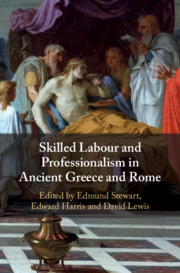Book contents
- Skilled Labour and Professionalism in Ancient Greece and Rome
- Skilled Labour and Professionalism in Ancient Greece and Rome
- Copyright page
- Contents
- Illustrations
- Contributors
- Acknowledgements
- Abbreviations
- Introduction
- Part I Professionals and Professional Identity in Greece and Rome
- Part II Specialization and the Division of Labour in the Ancient City
- Part III Case Studies of Professions 1: Sculpture
- Part IV Case Studies of Professions 2: Music and Athletics
- Part V Case Studies of Professions 3: A Profession of Arms?
- Index
- References
Part II - Specialization and the Division of Labour in the Ancient City
Published online by Cambridge University Press: 18 September 2020
- Skilled Labour and Professionalism in Ancient Greece and Rome
- Skilled Labour and Professionalism in Ancient Greece and Rome
- Copyright page
- Contents
- Illustrations
- Contributors
- Acknowledgements
- Abbreviations
- Introduction
- Part I Professionals and Professional Identity in Greece and Rome
- Part II Specialization and the Division of Labour in the Ancient City
- Part III Case Studies of Professions 1: Sculpture
- Part IV Case Studies of Professions 2: Music and Athletics
- Part V Case Studies of Professions 3: A Profession of Arms?
- Index
- References
- Type
- Chapter
- Information
- Skilled Labour and Professionalism in Ancient Greece and Rome , pp. 127 - 202Publisher: Cambridge University PressPrint publication year: 2020

